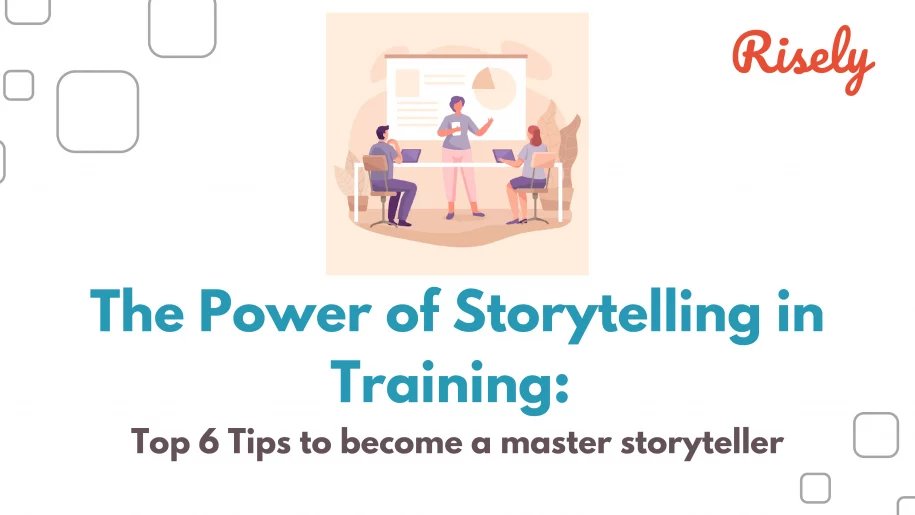The Power of Storytelling in Training: Top 6 Tips
Have you ever been engrossed in a story that made you forget everything else? That’s the power of storytelling. Stories can captivate us, evoke emotions, and make us remember things we would otherwise forget. The same can be said for learning. Incorporating storytelling in training can have a significant impact on the learning outcomes. In this blog, we will delve deeper into the significance of storytelling in training and how it can enhance emotional engagement and build a collective experience. We will also provide practical tips on incorporating storytelling into your training programs, including making your story relatable, understanding your audience, and paying attention to details. Lastly, we will showcase storytelling in training examples to help you understand how it plays out in practical life.Why Storytelling is important in Training?
Storytelling in training holds immense significance as an effective instructional strategy. It can create a more meaningful and memorable learning experience for learners, reinforcing key concepts and facilitating better understanding and retention. Learners are engaged in the training process by crafting a compelling training storyline with a clear protagonist and different decisions. Harnessing the power of storytelling drives behavioral change and creates a more impactful training program. Incorporating storytelling in eLearning and corporate training can reinforce learning meaningfully.The Impact of Storytelling on Learning Outcomes
Storytelling in training profoundly impacts learning outcomes by enhancing the memorability and relatability of information. Engaging learners through compelling stories fosters a deeper understanding and connection to the content. The immersive experience of story-based learning promotes higher engagement and retention. Moreover, stories enable learners to apply knowledge in real-life situations, nurturing critical thinking and problem-solving skills. By incorporating storytelling into training, organizations can achieve meaningful and long-lasting behavioral change, making learning and corporate training a more effective and meaningful way to deliver compelling training.Enhancing Emotional Engagement through Storytelling
Enhancing emotional engagement through storytelling is a powerful way to make the learning experience more engaging and memorable. Storytelling in training can increase motivation and interest in the subject by connecting with learners on an emotional level. Emotional engagement through storytelling also promotes empathy and understanding, fostering a deeper connection with the content. Well-crafted stories create anticipation and curiosity, driving learners to participate in the training process actively. Emotional storytelling fosters a positive learning environment and enhances employee engagement which plays a major role in taking an organization towards success.Building a Collective Experience via Stories
Stories can unite individuals, fostering collaboration and creating community in training environments. By incorporating diverse perspectives and experiences, storytelling promotes inclusivity and encourages active participation from all learners. Utilizing storytelling as a group activity promotes dialogue and discussion, leading to a deeper understanding of the subject matter. Learners can learn from each other’s experiences by sharing their stories and collectively build new knowledge and insights. Storytelling in training truly enables the building of a collective experience. Here are 10 innovative employee engagement ideas for you to go through.How to Incorporate Storytelling in Learning?
Discover practical strategies to integrate storytelling into your training programs seamlessly. Make your story relatable, tailor it to match your learners’ preferences, and use vivid details to captivate their attention. Explore various mediums and technologies to enhance the delivery of your story-based learning.Making Your Story Relatable
Crafting relatable stories is essential in training to engage learners. Understanding their background, interests, and experiences allows you to tailor your stories to resonate with your target audience. Incorporating familiar settings, characters, and situations will enable learners to connect with the content easily. Real-life examples and case studies demonstrate the practical application of concepts, making them more meaningful. Humanizing stories by highlighting challenges, successes, and emotions fosters emotional engagement. Addressing common problems or issues that learners may face further enhances relatability. This approach ensures a compelling training experience.Understanding Your Audience for Effective Storytelling
Understanding your audience to create compelling storytelling in e-learning and corporate training is essential. Conduct an audience analysis to understand their demographics, learning styles, and preferences. Adapt your storytelling approach to cater to different learner groups’ specific needs and expectations. Consider your audience’s cultural and social background to ensure that your stories are culturally sensitive and inclusive. Utilize storytelling techniques that align with your target audience’s cognitive abilities and attention spans. Continually seek feedback and refine your storytelling approach based on the response and engagement of your learners. By understanding your audience, you can deliver meaningful and compelling training in a way that resonates with them.The Importance of Detail in Storytelling
Incorporating details and descriptive language is vital to creating a rich and vivid story experience for learners. You can use sensory details, such as sights, sounds, and smells, to engage multiple senses and make the learning experience more immersive. Adding specific examples, facts, and figures lends credibility and context to your storytelling. To craft impactful stories, choose the most relevant and significant details while varying the level of detail based on the learning objectives and the complexity of the subject matter.Examples of Storytelling in Training
Here are two examples of how storytelling in training:- Customer Service Training:
Story: Imagine a scenario where a customer service representative shares a story about a challenging interaction with a customer. In the story, the representative details how they patiently listened to the customer’s concerns, empathized with their frustration, and then proactively resolved the issue, leaving the customer satisfied.
Training Connection: This story could be used to illustrate the importance of active listening, empathy, and problem-solving in customer service interactions. Learners can see the positive impact of these skills on customer satisfaction and retention. 2. Leadership Development Workshop:Story: In a leadership development workshop, the facilitator might share a personal story from their career journey. They talk about a time when they faced a difficult decision that involved balancing short-term results with long-term team morale. They share the process of weighing pros and cons, seeking advice, and ultimately making decisions that align with their team’s growth.
Training Connection: This story can emphasize the complexities of leadership decisions and the need to balance immediate goals with a broader perspective. It encourages learners to think critically, consider the impact of their decisions, and demonstrates the importance of transparent communication with their teams. In both examples, storytelling in training brings content to life by offering relatable scenarios and human experiences. These stories engage learners emotionally, making the lessons more memorable and encouraging participants to reflect on how they can apply similar approaches in their roles.How to learn storytelling?
Enhance your storytelling skills to create an engaging and immersive learning experience. Here are six tips for improving your storytelling skills for training:- Know Your Audience: Understand your learners’ backgrounds, interests, and needs. Tailor your stories to resonate with their experiences, making the content more relatable and engaging.
- Clear Objectives: Define the learning objectives of your training. Craft stories that align with these objectives, ensuring that each narrative reinforces the key takeaways you want learners to grasp.
- Structure and Flow: Organize your stories with a clear beginning, middle, and end. Introduce the characters, set the context, present the conflict or challenge, and conclude with a resolution related to the learning objectives.
- Vivid Imagery: Use descriptive language to paint a vivid picture. Engage learners’ senses by incorporating details that help them visualize the story’s scenes, characters, and situations.
- Emotional Connection: Evoke emotions to captivate learners’ attention. Share relatable struggles, successes, and challenges that create an emotional bond between learners and the content.
- Relevance and Practicality: Ensure your stories are relevant to the learners’ roles and goals. Highlight how the lessons from the story can be practically applied in their daily work or situations.
Conclusion
In conclusion, storytelling in training has a profound impact on learning. It enhances emotional engagement, builds a collective experience, and makes the content relatable to the audience. By incorporating storytelling into your training programs, you can create a more immersive and memorable learning experience for your learners. Remember to understand your audience, add detail to your stories, and use real-life examples to make your training more effective. Developing your storytelling skills will benefit your training programs and make you a more engaging and effective communicator. So embrace the power of storytelling and unlock the full potential of learning.Handle performance management effectively with one-on-one meetings.
Take the free one-on-one assessment to navigate challenging situations as a first-time manager.
Other Related Blogs


